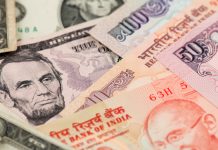- Indian Rupee (INR) rises after two days of gains
- Oil eases as Venezuela oil sanctions are relaxed
- US Dollar (USD) falls ahead of Fed Chair Powell’s speech
- US treasury yields near 5%
The US Dollar Indian Rupee (USD/INR) exchange rate is falling after two days of gains. The pair closed +0.06% higher in the previous session, settling on Thursday at 83.29. At 15:30 UTC, USD/INR trades -0.17% at 83.15 and trades in a range of 83.10 to 83.29.
The Indian rupee was unmoved by weakness in other Asian currencies at the start of the day, most likely owing to an intervention from the central bank, which helped keep the Rupee off record lows.
Meanwhile, an easing in oil prices was also helping the Rupee pushed higher. Oil traded over 1% lower as the US sanctions on Venezuelan oil were relaxed as the government and the main opposition agreed on a deal for fairer elections in 2024.
The US Dollar is falling across the board. The US Dollar Index, which measures the greenback versus a basket of major currencies, trades -0.24% at the time of writing at 106.29, after two days of gains.
The US dollar is falling as investors look cautiously ahead to a speech by Federal Reserve chair Jerome Powell, who will speak at the Economic Club of New York.
His comments will be watched closely for clues over the future path of interest rates after a series of strong data suggests that the US economy is proving more resilient than initially expected.
Today, US jobless claims fell to the lowest level since January at 198,000, down from 212,000, highlighting the tight labour market. Yesterday, retail sales also came in stronger than expected, underscoring the strength of the US consumer despite the Federal Reserve raising interest rates aggressively.
However, recent Fed speakers have indicated that it may not be necessary to hike interest rates again given that higher U S treasury Dales on tightening financial conditions.
However, it’s worth noting that US treasury yields are trading close to 5% level, which was last seen in 2007, on the prospect that the Federal Reserve could keep interest rates higher for longer.





